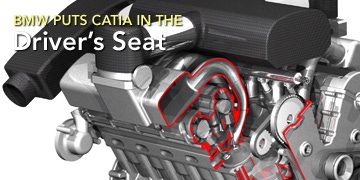March 18, 2009

BMW has announced it isstandardizing on Dassault'sCATIA 3-D CAD tool, a move it says will establish a single digitaldevelopment system that will reduce the complexity of supporting multiplesystems while aiding in skills sharing and design reuse for BMW engines.
By leveraging CATIA across its organization, BMW hopes tocreate a single reference model for the design of all future BMW engines acrossits fuel- and diesel-powered cars, motorcycles and new line of eco-friendlyhybrid vehicles. By having a single digital reference model that can be updatedand shared across the globe, BMW will be able to respond more quickly toconsumer changes prior to production as well as garner efficiencies resultingfrom having common tools, methods and processes across different enginedevelopment projects, according to Frank Wienstroth, a spokesperson for BMWGroup.
Standardization of data formats (CATIA as the standard CADformat and JT as the standard visualization format) is another benefit of theconsolidation, Wienstroth says. One CAD format will allow for more complete andintegrative digital mock up for engines and power train development as well ashelp facilitate skill sharing across the different engine development projects,he says. From an IT perspective, a single CAD system helps reduce costs byreducing the complexities of supporting interfaces to multiple CAD systems andBMW's PLM platform.
In doing the standardization, BMW will be phasing out theuse of other CAD tools, including PTC'sPro/ENGINEER, Wienstroth says. The phase-out will take approximatelysix to eight months for the petrol engine development group and around 12 to 18months for the motorcycle development organization. BMW will continue to employother computer-aided tools for its vehicle design process, including simulationtools for vehicle crash testing and temperature and durability studies; computer-aidedstyling and sketching programs, and computer-aided manufacturing programs todevelop and design the molding and stamping as well as production lineprocesses.
Stephan Clambaneva, IBM's global PLM industry leader, hailedBMW's move as a way to achieve operational efficiencies, especially in light ofthe current harsh economic climate. "Look at this from an operationalexcellence perspective - by leveraging a single platform, they don't have toreinvent the wheel every time they want to design a new engine," he says."By focusing on reuse, the design rules, methodologies and knowledge used by one team can be leveraged across others that are working independently.They'll be able to digitally share a master version of an engine or gearbox acrossdifferent teams, and one single digital reference model can be updated andshared instantly across the globe."
One challenge for BMW may be getting engineers to commit tousing a single CAD platform, especially if they've grown accustomed to an alternative.BMW officials don't see it that way, however. "We believe the advantages of asingle system will be sufficient motivation for our engineers," Wienstrothsays. "Furthermore, we will not provide ProE installations so there is no wayto fall back to other systems. By professional training, we will make sure thatour engineers will be as familiar with CATIA as they were with Pro/E."
Ed Miller, president of CIMdata Inc., a consultancy specializing in engineering and product development, says the standardization on a single CAD tool is not all that is needed and that consistent processes are key to making this consolidation a success. "To make this work so thatall parties are comfortable requires development of processes that are bothcommon and simple enough for all associated individuals across the organizationto understand and utilize," he explains. "Once the common processes aredeveloped, consistent and comprehensive education is demanded to ensure thatthe processes (and the most effective use of the CAD tools to support thoseprocesses) are effectively used and that the engineers are able to benefit fromtheir use."

BMW Puts CATIA in the Driver
About the Author(s)
You May Also Like





